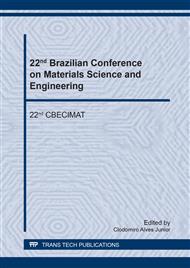p.67
p.73
p.79
p.85
p.90
p.95
p.101
p.107
p.115
Estimate of the Nanoparticles Size of Magnetite Produced by Co-Precipitation Method
Abstract:
In the present study, Fe3O4 nanoparticles type/core layer were synthesized by co-precipitation wet method and coated with a polymer mixture of polyethylene glycol (PEG). It was performed a study about the effect of duration in maceration time on the final size of nanoparticles in in order to get reaching the maximum condition of disintegration of the crystals. The samples were synthesized according to the same procedure and amount of reactants used synthetic sequence for all samples, only varying the time spent by each sample maceration process done after synthesis. The different times for the maceration samples were 3 minutes, 5 minutes, 7 minutes, 10 minutes, 12 minutes, 20 minutes and finally 30 minutes. The nanoparticles were characterized by Nanosight, DR-X, rietvield analysis and hysteresis curves plotter techniques. The results showed that the grain size of the particles stabilizes at maceration times of more than 20 minutes. The samples presented a satisfactory hysteresis curve indicating the presence of superparamagnetic behavior expected in hyperthermia treatment.
Info:
Periodical:
Pages:
90-94
Citation:
Online since:
September 2018
Price:
Сopyright:
© 2018 Trans Tech Publications Ltd. All Rights Reserved
Share:
Citation:


